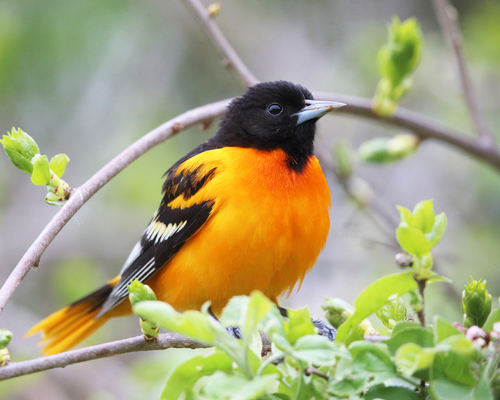
Baltimore Oriole
The Baltimore Oriole (Icterus galbula) is a vibrant, medium-sized songbird known for its striking orange and black plumage, often considered a symbol of spring in eastern North America. This species plays a crucial role in controlling insect populations, particularly during the breeding season. It also has cultural significance, lending its name to the Baltimore Orioles Major League Baseball team due to the male's plumage resembling the colors on the coat-of-arms of Lord Baltimore.
17-22 cm
Length
23-32 cm
Wingspan
Least Concern
Conservation Status
Distribution
Breeds across eastern North America, from southeastern Canada to the central and southeastern United States. Winters in Central America, northern South America, and the Caribbean.
Lifespan
Up to 11 years in the wild; longer in captivity (Not Evaluated).
Baltimore Oriole's Habitat
Habitat Types
Deciduous forests, Open woodlands, Orchards, Parks, Suburban areas with scattered trees
Climate Zones
Temperate, Subtropical
Adaptations
Adaptable to a variety of wooded habitats, provided there are tall trees for nesting and a sufficient supply of insects and fruits. Their strong, pointed bills are well-suited for both gleaning insects and probing flowers for nectar.
Variations
No recognized subspecies, but some slight variations in plumage brightness and size have been observed across their range.
Appearance
Breeding Plumage
Adult males have bright orange underparts, shoulders, and rump, with a black head, back, wings, and tail. Females and immature birds are duller, with yellowish-orange underparts and olive-brown upperparts. Non-breeding plumage is similar to breeding plumage, but may be slightly less vibrant.
Seasonal Feather Changes
Minor seasonal variations, primarily in the intensity of coloration.
Sex Based Plumage Differences
Significant sexual dimorphism; males are much more brightly colored than females.
Notable Features
Bright orange and black plumage in adult males., Strong, pointed bill., White wing bars.
Diet and Feeding
Primary Foods
Insects, Caterpillars, Fruits, Nectar, Spiders
Foraging Behavior
Forages actively in trees and shrubs, gleaning insects from leaves and branches. Also probes flowers for nectar and eats fruits.
Specializations
Their pointed bill is well-suited for probing into flowers and extracting insects from crevices. They are also adept at catching insects in flight.
Seasonal Diet Variations
Diet shifts with the seasons. During the breeding season, they primarily eat insects, especially caterpillars. In the fall and winter, they consume more fruits and nectar.
Behavior
Social Structure
Generally solitary or in pairs during the breeding season. May form small flocks during migration and on wintering grounds.
Communication
Clear, flute-like whistles, Chattering calls, Visual displays (e.g., wing fluttering)
Migration
Migrates at night, often in mixed-species flocks. They travel long distances between their breeding and wintering grounds.
Territorial or Group Behaviors
Males are territorial during the breeding season, defending their nesting area from other males. Females may also defend the nest.
Conservation
Threats
Habitat loss, Pesticide use, Collisions with buildings and windows, Climate change (potential shifts in habitat and food availability)
Protection Programs
Migratory Bird Treaty Act protection
Local National Laws
Protected under the Migratory Bird Treaty Act in the United States and Canada.
Population Trend
Stable
Population Estimates
Global population estimated at 12 million (Partners in Flight).
Interesting Facts
Baltimore Orioles are known for their intricately woven nests.
These nests are suspended from branches, often high in trees, and are made of strong plant fibers.
They are named after Lord Baltimore.
The male's colors resemble those on Lord Baltimore's coat-of-arms.
Baltimore Orioles are attracted to oranges.
People often put out orange halves to attract them to their yards.
Faqs about Baltimore Oriole
What do Baltimore Orioles eat?
They eat insects, caterpillars, fruits, and nectar, with their diet varying seasonally.
Where do Baltimore Orioles nest?
They build hanging, pouch-like nests high in trees, often in deciduous forests or open woodlands.
Are Baltimore Orioles endangered?
No, they are classified as Least Concern by the IUCN.
How can I attract Baltimore Orioles to my yard?
Provide a source of fresh water, plant native trees and shrubs that produce fruits, and put out orange halves or grape jelly.
Copyright @ Nature Style Limited. All Rights Reserved.
 English
English